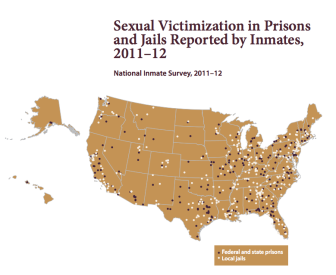
National Inmate Survey, 2011–12 / U.S Department of Justice, Bureau of Justice Statistics
From the BJS New Report: Sexual Victimization in Prisons and Jails Reported by Inmates, 2011–12
The United States Bureau of Justice Statistics (BJS) released data from the 2011-2012 National Inmate Survey (NIS) on Thursday, revealing new findings about rates of sexual victimization in the nation’s prisons.
Some advocates claim that the new figures, however, may underreport the amount of juvenile inmate sexual victimizations that goes on in the nation’s jails and prisons.
“Previous studies and the experiences of young people in the adult criminal justice system document that youth are at greatest risk of sexual victimization in adult jails and prisons,” said Campaign for Youth Justice CEO and President Liz Ryan. “This study tells us that youth face sexual victimization in adult institutions, but due to underreporting by youth in challenging adult facility conditions, we need more research to know more about this problem.”
The findings include the first-ever nationalized estimates for the sexual victimization of juveniles incarcerated in adult facilities -- with the BJS stating that roughly 1.8 percent of 16- and -17 year-olds held in U.S. adult facilities report being sexually assaulted by other inmates.
The data includes a sample size of nearly 100,000 adult inmates and approximately 7,000 juvenile inmates in state- and federally- operated prisons as well as locally-ran jails. Per the new BJS findings, the percentage of juveniles reporting sexual victimization by other inmates is marginally higher than the percentage of adult prisoners reporting such victimization in U.S. local jails (1.6 percent) and lower than the percentage of adults in U.S. state and federal prisons that report being sexually attacked (2 percent.)
However, with staff sexual misconduct factored into reports, the percentage of underage inmates stating they experienced abuse jumped to 4.5 percent and 4.7 percent, respectively, for juveniles in U.S. prisons and jails. While these rates are higher than those reported by adult inmates (which stood at 3.2 percent in jails and 4 percent in prisons) the BJS did not find the differences to be statistically significant
“These data do not support the conclusion that juveniles held in adult prisons and jails are more likely to be sexually victimized in other age groups,” the report reads.
The national findings run contrary to previous BJS research, which suggested as much as 21 percent of all substantiated victims of inmate-on-inmate sexual abuse in U.S. jails in 2005 were juveniles.
Brenda Smith, Director of The Project on Addressing Prison Rape at American University’s Washington College of Law, believes that the new numbers underestimate the rate of juvenile inmate sexual victimization in U.S. jails and prisons.
“During my tenure as a commissioner on the National Prison Rape Elimination Commission, we found that youth are at particular risk of abuse in custodial settings – both juvenile and adult facilities,” she said. “While I appreciate BJS taking a closer look at victimization of youth in adult facilities, these findings call for a closer look at the data, and conflict with existing research -- their own and others -- and from the previous accounts given by youth to the people that they trust.”
According to BJS findings, two-thirds of juvenile inmates that reported being sexually attacked by other inmates were victimized more than once, while three-quarters of juvenile inmates that reported experiencing staff sexual misconduct said they were victimized repeatedly.
Additionally, less than one-sixth of juveniles reporting inmate sexual abuse said they informed others of incidents, while less than a tenth of juveniles experiencing staff sexual misconduct said they informed family members, friends or facility personnel of such incidents.
